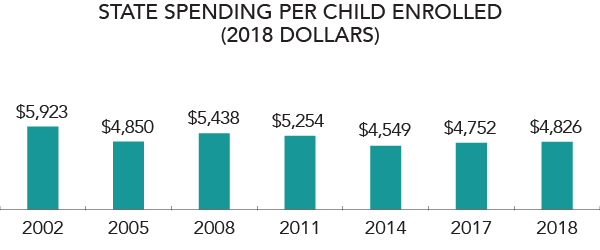How well is Alabama serving its Black and Latino 3- and 4-year-olds?
Select any of the tabs below to get more specifics about different programs happening in the state.
10/10
Quality Rating
Across the nation, far too few Black and Latino children attend a high-quality state-funded preschool
In a first-of-its-kind analysis examining race and ethnicity in state-funded preschool programs, The Education Trust found that only 1 percent of Latino children and 4 percent of Black children were enrolled in high-quality state preschool programs. The analysis, which examines data from 26 states where enrollment is reported by race and ethnicity, found that no state truly provided high-quality and high-access for Black and Latino 3- and 4-year-olds.
How well is Alabama serving its Black and Latino 3- and 4-year-olds when compared to other states?
What can Alabama’s state leaders do to make state preschool programs more equitable?
Alabama’s preschool program achieved high quality by meeting 10 out of 10 quality benchmarks, but served only 9% of its Latino children and 21% of its Black children. For every 10 Latino children that would be enrolled in Alabama’s state-funded preschool program if they were fully represented, only 7 were enrolled. Alabama’s state leaders should do the following to continue to invest in the quality of its preschool program and to increase meaningful access to its preschool program for Black and Latino children:
Expand state-funded preschool to include 3-year-olds. Alabama should support programs for both 3- and 4-year-olds, as both years are highly sensitive periods of brain development and learning that build upon one another toward a strong start in kindergarten and beyond. When states do not provide ECE for 3-year-olds, many families are left to find other, often very expensive means of preschool.
Prioritize expansion in underserved communities. While Alabama should ensure access to high-quality ECE for all young children, it should prioritize expanded access in neighborhoods with the highest number or percentage of historically underserved children (including Black and Latino children) who are not currently enrolled in a high-quality program.
Spread the word to Black and Latino families. Alabama should conduct substantial outreach using strategies to increase awareness of ECE programs such as providing outreach materials in multiple languages including Spanish and engaging directly with communities to raise program awareness.
Make enrollment easy. Alabama should offer enrollment materials in multiple languages including Spanish, that take little time to complete, and that let families enroll online, by mail, and in person. Enrollment materials should not request information regarding citizenship status, immigration status, or work status of children or family members.
Offer hours and locations that align with the schedules and commutes of working families. Alabama should align program hours with the most common work schedules for low-income families, including shift and seasonal work, and provide wraparound child care. It should strategically locate programs at or near Alabama’s largest work sites for Black and Latino families and prioritize public transit accessibility of ECE programs.
Eliminate suspensions and expulsions. Both of these practices disproportionately affect young children of color, and should be replaced with evidence-based practices and the professional development necessary to implement them.
Support families. Alabama should ensure that state preschool programs can connect families to support services, including mental health services, emergency crisis services, early intervention, home visiting, developmental assessment, and services facilitating seamless transitions into kindergarten.
Support dual language learners. Alabama should offer dual language immersion programs in Spanish (the most common language of the state’s Limited English Proficient individuals), and prioritize access for Spanish-speaking dual language learners (children with a home language of Spanish who are developing Spanish and English at the same time). Alabama should invest in recruiting and retaining qualified, bilingual ECE staff and training educators in evidence-based dual language immersion models, and provide all ECE staff, whether in dual language immersion programs or not, with professional development to meaningfully support families with a home language other than English even when staff do not speak families’ home language.
Diversify the workforce. All children benefit from diverse educators, and research shows that children of color and dual language learners especially benefit from teachers who are reflective of students’ cultural and linguistic diversity People of color and bilingual people should be represented throughout the various roles within ECE programs, including administrators and lead teachers.
Be the First to Know!
Sign Up for Updates from Ed Trust
How is the country doing?
In a first-of-its-kind analysis examining race and ethnicity in state-funded preschool programs, The Education Trust found that only 1 percent of Latino children and 4 percent of Black children were enrolled in high-quality state preschool programs. The analysis, which examines data from 26 states where enrollment is reported by race and ethnicity, found that no state truly provided high-quality and high-access for Black and Latino 3- and 4-year-olds.
Additional State Data
The data used for this page comes from the National Institute for Early Education Research. See addtional data charts below from NIEER’s annual state profiles.


